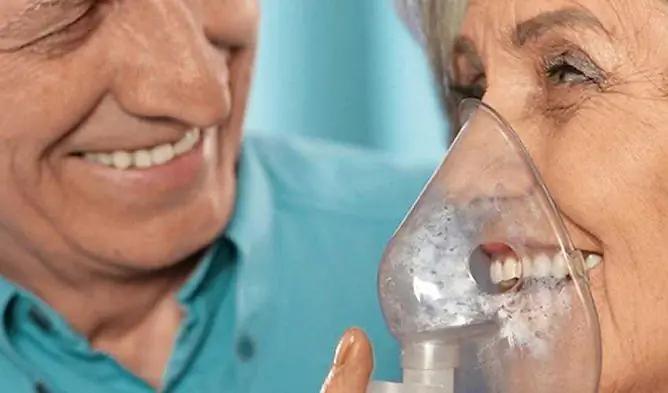- Author Rachel Wainwright [email protected].
- Public 2023-12-15 07:39.
- Last modified 2025-11-02 20:14.
Bramitob
Bramitob: instructions for use and reviews
- 1. Release form and composition
- 2. Pharmacological properties
- 3. Indications for use
- 4. Contraindications
- 5. Method of application and dosage
- 6. Side effects
- 7. Overdose
- 8. Special instructions
- 9. Application during pregnancy and lactation
- 10. Use in childhood
- 11. In case of impaired renal function
- 12. Drug interactions
- 13. Analogs
- 14. Terms and conditions of storage
- 15. Terms of dispensing from pharmacies
- 16. Reviews
- 17. Price in pharmacies
Latin name: Bramitob
ATX code: J01GB01
Active ingredient: tobramycin (Tobramycin)
Producer: Holopack Verpackungstechnik, GmbH (Germany)
Description and photo update: 2019-11-07

Bramitob is a broad-spectrum antibacterial agent for inhalation from the aminoglycoside group.
Release form and composition
Dosage form - solution for inhalation: transparent, from yellow to light yellow (in a cardboard box 4, 7 or 14 strips containing 4 hermetically sealed plastic ampoules of 4 ml of solution, and instructions for the use of Bramitoba).
Composition of 1 ml solution:
- active substance: tobramycin - 75 mg;
- auxiliary components: 1M sulfuric acid solution - 0.4 ml (up to pH 4.5-5.5); 1M sodium hydroxide solution - up to pH 4.5-5.5; sodium chloride - 4.5 mg; water for injection - up to 1 ml.
Pharmacological properties
Pharmacodynamics
Tobramycin is an aminoglycoside antibiotic that is produced by microorganisms of the genus Streptomyces tenebrarius. The main mechanism of its action is associated with a violation of protein synthesis, due to which the permeability of the cell membrane changes, the damage to the membrane increases, and cell death occurs. The antibiotic has a bactericidal effect at concentrations slightly higher than or equal to the suppressive concentrations.
Bramitob is primarily active against gram-negative aerobic microorganisms. In relation to most gram-positive bacteria and anaerobic microorganisms, it exhibits low activity.
Compared with gentamicin, the drug is more active against individual strains of Proteus and Pseudomonas aeruginosa. Approximately half of the strains of Pseudomonas aeruginosa that show resistance to gentamicin are sensitive to tobramycin.
In the sputum of patients with cystic fibrosis, the minimum inhibitory concentration of tobramycin with inhalation is significantly higher than with parenteral administration.
Pharmacokinetics
After inhalation with the use of 0.3 g of Bramitoba, the maximum concentration of the drug in the sputum of patients with cystic fibrosis is reached after 30 minutes and is approximately 1289 μg per 1 g. Along with this, the maximum concentration in blood plasma is reached after approximately 1.5 hours and is 758 ng for 1 ml. The half-life of the drug is 4.5 hours.
The drug absorbed into the blood is excreted by glomerular filtration through the kidneys.
Indications for use
Bramitob is prescribed for patients with cystic fibrosis to treat respiratory tract infections caused by Pseudomonas aeruginosa.
Contraindications
Absolute:
- children under 6 years of age;
- lactation period;
- individual intolerance to the components of the drug.
Relative (solution for inhalation Bramitob is prescribed under medical supervision):
- diabetes;
- renal failure;
- cardiac ischemia;
- chronic heart failure in the stage of decompensation;
- hearing impairment;
- acute hemoptysis;
- dysfunction of the vestibular apparatus or neuromuscular pathology (for example, parkinsonism and other conditions accompanied by muscle weakness, including myasthenia gravis);
- pregnancy.
Bramitob, instructions for use: method and dosage
Bramitob solution for inhalation is used by means of a nebulizer.
In children over 6 years of age and adults, it is recommended to use 1 ampoule in the morning and evening for 28 days. The interval between procedures should be approximately 12 hours, but not less than 6 hours.
After 28 days of using Bramitoba, it is necessary to take a 28-day break, after which the treatment should be continued for another 28 days.
The patient's body weight is not taken into account to establish the dosage regimen. All patients should use 1 ampoule of solution (0.3 g of tobramycin) twice a day.
To open the detachable ampoule, it is first bent in both directions from the strip, and then its upper and lower parts are sequentially separated. After that, the upper part of the ampoule is rotated relative to the body in the direction indicated by the arrow. The solution is poured into the glass neck of the nebulizer by moderate pressure on the walls of the open ampoule.
The solution poured into the nebulizer (0.3 g) is injected by inhalation over 10-15 minutes using the PARI LC Plus reusable device. This nebulizer contains compressors that, when connected to the PARI LC Plus, deliver 4 to 6 liters per minute and / or a back pressure of 110 to 217 kPa.
During the procedure, the patient should be in a standing or sitting position and breathe as usual through the mouthpiece of the nebulizer. To make breathing easier through the mouth, the patient may use a nose clip.
Upon completion of inhalation, the device must be disassembled. After each procedure, it is important to thoroughly wash its individual parts, excluding the tube, with hot water and liquid detergent, rinse and wipe dry with a dry clean cloth that does not leave fibers.
Separate parts of the nebulizer other than the tube should be disinfected after cleaning in accordance with the above instructions. To do this, you can use one of two methods to choose from:
- Boil in water for 10 minutes.
- Immersion of parts of the device for 1 hour in a solution of acetic acid 9% and hot water (diluted in proportions 1 ÷ 3), after which the parts are washed with hot water, and the used solution is poured out.
After the end of disinfection, wipe the nebulizer parts dry with a clean cloth.
Side effects
Possible side effects of Bramitoba [> 10% - very common; (> 1% and 0.1% and 0.01% and <0.1%) - rarely; <0.01%, including isolated messages - very rare]:
- musculoskeletal system: very rarely - back pain;
- blood and lymphatic system: very rarely - lymphadenopathy;
- sense organs: rarely - hearing loss, ringing in the ears; very rarely - pain in the ear, labyrinth and vestibular disorders;
- central and peripheral nervous system: rarely - dizziness, headache; very rarely - drowsiness;
- gastrointestinal tract: rarely - change in taste, ulcerative stomatitis, nausea, vomiting; very rarely - diarrhea;
- respiratory organs: infrequently - pharyngitis, increased cough, shortness of breath, voice change; rarely - rhinitis, nosebleeds, laryngitis, deterioration of lung function, hemoptysis, increased sputum production, bronchospasm; very rarely - sinusitis, hypoxia, hyperventilation;
- local reactions: very rarely - oral candidiasis, fungal infections;
- others: rarely - fever, asthenia, chest pain, anorexia, skin rash; very rarely - abdominal discomfort and pain.
Overdose
The main symptom of an inhalation overdose of tobramycin is pronounced hoarseness. Due to the fact that tobramycin is poorly absorbed from the gastrointestinal tract, the development of toxic effects is unlikely when it is involuntarily ingested. Accidental intravenous injection of Bramitoba can lead to the development of symptoms and signs of systemic overdose of tobramycin - vertigo, dizziness, ringing in the ears, hearing loss, blockade of neuromuscular conduction, impaired renal function, respiratory distress syndrome.
Therapy: immediate withdrawal of Bramitoba, conducting a study of indicators of renal function, determining the concentration of tobramycin in serum (to control overdose).
special instructions
The appointment of Bramitoba should be issued by a medical professional who has experience in managing patients with cystic fibrosis. The duration of the course of therapy is determined by the doctor, taking into account the clinical picture of the pathology. If worsening pulmonary function is confirmed, additional antibiotic treatment should be given.
It should be borne in mind that inhalation use of the solution can lead to the development of bronchospasm. In this regard, the first dose of the drug should be used under medical supervision. If a bronchodilator is already included in the therapy regimen, it is used before the first procedure. Forced expiratory volume is measured before and after inhalation. Patients not receiving a bronchodilator who show signs of iatrogenic bronchospasm after inhalation with Bramitob, undergo a second procedure using a bronchodilator. Bronchospasm, which manifests itself against the background of its use, may indicate an allergic reaction, which requires discontinuation of therapy and appropriate pathogenetic treatment for its relief.
During the period of drug therapy, standard chest physiotherapy should be continued. If there is a clinical indication, the use of bronchodilators continues. In cases where the patient is simultaneously prescribed several methods of treatment, they are used in the following order:
- Use of a bronchodilator;
- Performing respiratory physiotherapy;
- Introduction of other inhalation agents;
- Inhalation with Bramitob.
It should be borne in mind that Bramitob cannot be mixed with other inhaled drugs.
With extreme caution, the solution should be used in patients with parkinsonism or other conditions that are accompanied by muscle weakness (including myasthenia gravis). This is due to the fact that aminoglycosides can have a curariform effect on neuromuscular conduction and, as a consequence, increase muscle weakness.
Against the background of the use of aminoglycosides, ototoxicity (ataxia, hypoacusia, non-systemic and systemic dizziness) may develop.
The attending physician should be aware that aminoglycosides may have cochlear and vestibular toxicity. In this regard, during the period of treatment with Bramitob, it is important to assess the function of hearing. Patients who have previously received aminoglycoside antibiotics for a long period are advised to undergo audiometric tests before starting inhalation with the solution. When treating dizziness, it must be borne in mind that it is a symptom of ototoxicity. Hearing loss or dizziness during the period of using the solution requires an audiological examination.
During inhalation, a cough reflex may appear. In patients with acute hemoptysis, Bramitob should be prescribed only in cases where the potential benefit of therapy is significantly higher than the possible risk of provoking further bleeding.
Against the background of the use of tobramycin, an increase in the minimum inhibitory concentration of aminoglycosides in relation to the studied isolated strains of Pseudomonas aeruginosa is sometimes noted. Pseudomonas aeruginosa strains can develop resistance when tobramycin is administered intravenously.
Application during pregnancy and lactation
Bramitob during pregnancy is prescribed only in cases where the potential benefits to the mother significantly outweigh the potential risks to the fetus.
If inhalation is necessary during lactation, breastfeeding should be discontinued.
Pediatric use
For patients under 6 years old, Bramitob is not prescribed.
With impaired renal function
With caution and subject to monitoring serum concentrations of tobramycin, the solution is used in proven or suspected renal failure. Renal function should be assessed periodically. For example, the assessment of the level of creatinine and urea should be carried out at least 1 time during 6 courses of treatment with Bramitob.
The appearance of symptoms of nephrotoxicity is an indication for the cessation of inhalation of tobramycin until its minimum concentration in serum decreases to less than 2 μg per 1 ml. After this, procedures can be resumed only for medical reasons. Patients receiving parenteral treatment in combination with other aminoglycoside antibiotics should be carefully monitored, since they may develop cumulative toxicity.
Drug interactions
With the combined use of Bramitoba with other parenteral or oral antibacterial agents with antipseudomonal activity, inhaled corticosteroids, β2-adrenergic agonists or mucolytics, no significant drug interactions were identified.
It is recommended to avoid combined or sequential use of Bramitoba for inhalation with other potentially nephro- or ototoxic agents. The toxicity of aminoglycosides can be increased with the simultaneous use of certain diuretics by changing the concentration of the antibiotic in tissues and serum. The combined use of tobramycin for inhalation with mannitol, urea, furosemide and ethacrynic acid is contraindicated.
Simultaneous parenteral administration of tacrolimus, cyclosporine, cephalothin, amphotericin B, cholinesterase inhibitors, botulinum toxin (neuromuscular effects are possible), platinum preparations (there is a risk of increased ototoxicity and nephrotoxicity) or polymyxins (potential increase in nephrotoxicity) can lead to increased toxicity of aminoglycosides.
Analogs
Bramitob's analogues are Tobrex, Alemtob, Tobi, Tobriss, Tobramycin, Brulamycin, Tobropt, Toby Podhaler, Tobramycin-Gobbi, Tobrosopt, etc.
Terms and conditions of storage
Store at 2-8 ° C (refrigerator) away from heating appliances, in original packaging to protect from light. Do not freeze.
Keep out of the reach of children.
Shelf life is 2 years.
Terms of dispensing from pharmacies
Dispensed by prescription.
Reviews about Bramitoba
According to a few reviews, Bramitob is an effective drug used to treat Pseudomonas aeruginosa respiratory tract infections in patients with cystic fibrosis. Among the disadvantages, the development of side effects in the form of nausea, depression, loss of orientation in space is noted.
Price for Bramitob in pharmacies
The approximate price for Bramitob, a solution for inhalation (4 ml in plastic ampoules, 56 ampoules in a package) is 100,360 rubles.

Anna Kozlova Medical journalist About the author
Education: Rostov State Medical University, specialty "General Medicine".
Information about the drug is generalized, provided for informational purposes only and does not replace the official instructions. Self-medication is hazardous to health!






